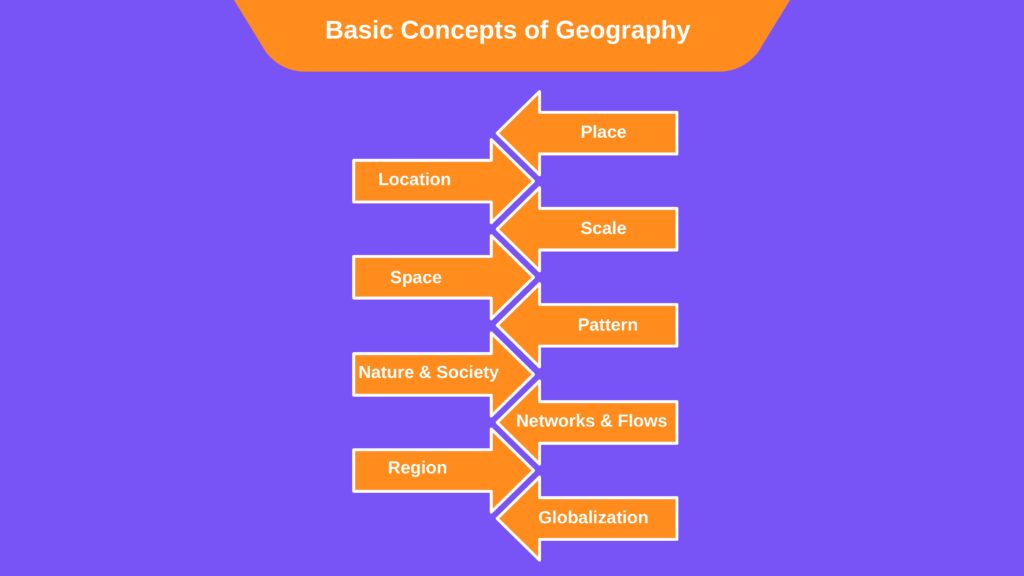Basic Concepts of Geography
Geographical Thought
Index
Introduction
Geography, often hailed as the spatial science, is a multifaceted discipline that delves into the intricate spatial behavior of people, the relationships between places on Earth's surface, and the underlying processes shaping these phenomena. The fundamental concepts of geography provide a framework for understanding the complexities of the world and its spatial dynamics.
Location: Location forms the cornerstone of geography, referring to the position of a place on Earth's surface. It involves both absolute location, pinpointed by coordinates such as latitude and longitude, and relative location, which considers a place's position in relation to other landmarks or features.
Place: Place goes beyond mere coordinates; it encapsulates the unique characteristics and attributes that define a particular area. These characteristics include physical features, such as topography and climate, as well as human elements like culture, language, and built environment. Places acquire significance through their tangible and intangible attributes, shaping the experiences of those who inhabit or interact with them.
Scale: Scale is a crucial concept in geography, referring to the level of analysis or observation. Geographers explore phenomena at various scales, from the local to the global, recognizing that different scales reveal different insights. Whether examining patterns in a neighborhood or analyzing global migration trends, understanding scale provides context and perspective.
Space: Space represents the physical extent and arrangement of objects and phenomena. Geographers study the organization and distribution of space, exploring how it influences human activities and environmental processes. Space is not merely an empty canvas but a dynamic arena where interactions and transformations unfold.
Pattern: Patterns in geography refer to recurring spatial arrangements or distributions of phenomena. These patterns may emerge from natural processes, such as the distribution of ecosystems, or human activities, like the layout of urban settlements. Analyzing patterns enables geographers to discern underlying processes and relationships shaping spatial phenomena.
Nature and Society (Human-Environmental Interaction): Human-Environmental Interaction focuses on the reciprocal relationship between people and their environment. It examines how human activities impact the natural world and how environmental conditions, in turn, shape human behavior and societal development. This concept underscores the interconnectedness of nature and society, emphasizing the need for sustainable interactions to ensure the well-being of both.
Networks and Flows (Spatial Interaction): Spatial Interaction explores the connections and movements between places. Networks, such as transportation and communication systems, facilitate the flow of goods, information, and people across space. Geographers study the patterns and dynamics of spatial interaction to understand the spatial integration of regions and the diffusion of ideas, resources, and culture.
Region and Regionalization: Regions are geographic areas characterized by common attributes or features that distinguish them from surrounding areas. Regionalization involves the delineation and classification of these areas based on criteria such as physical characteristics, economic activities, or cultural practices. Regions serve as analytical units for understanding spatial variations and identifying patterns of similarity and difference.
Globalization: Globalization refers to the increasing interconnectedness and interdependence of societies and economies on a global scale. It encompasses the flow of goods, capital, information, and people across borders, transcending traditional spatial boundaries. Geographers study globalization to analyze its impacts on cultures, economies, and environments, as well as to understand the uneven distribution of its benefits and challenges.

In essence, the basic concepts of geography provide a lens through which to examine the spatial dimensions of the world. By exploring location, place, scale, space, pattern, human-environment interaction, spatial interaction, region, and globalization, geographers gain insights into the complex interplay between physical and human phenomena across different scales and contexts.
These concepts serve as the foundation for addressing pressing societal issues, managing natural resources sustainably, and fostering inclusive and equitable development in an increasingly interconnected world.
Advertisement
Share
Other Topics
Unit - I
Advertisement
Back to
Advertisement
Advertisement

